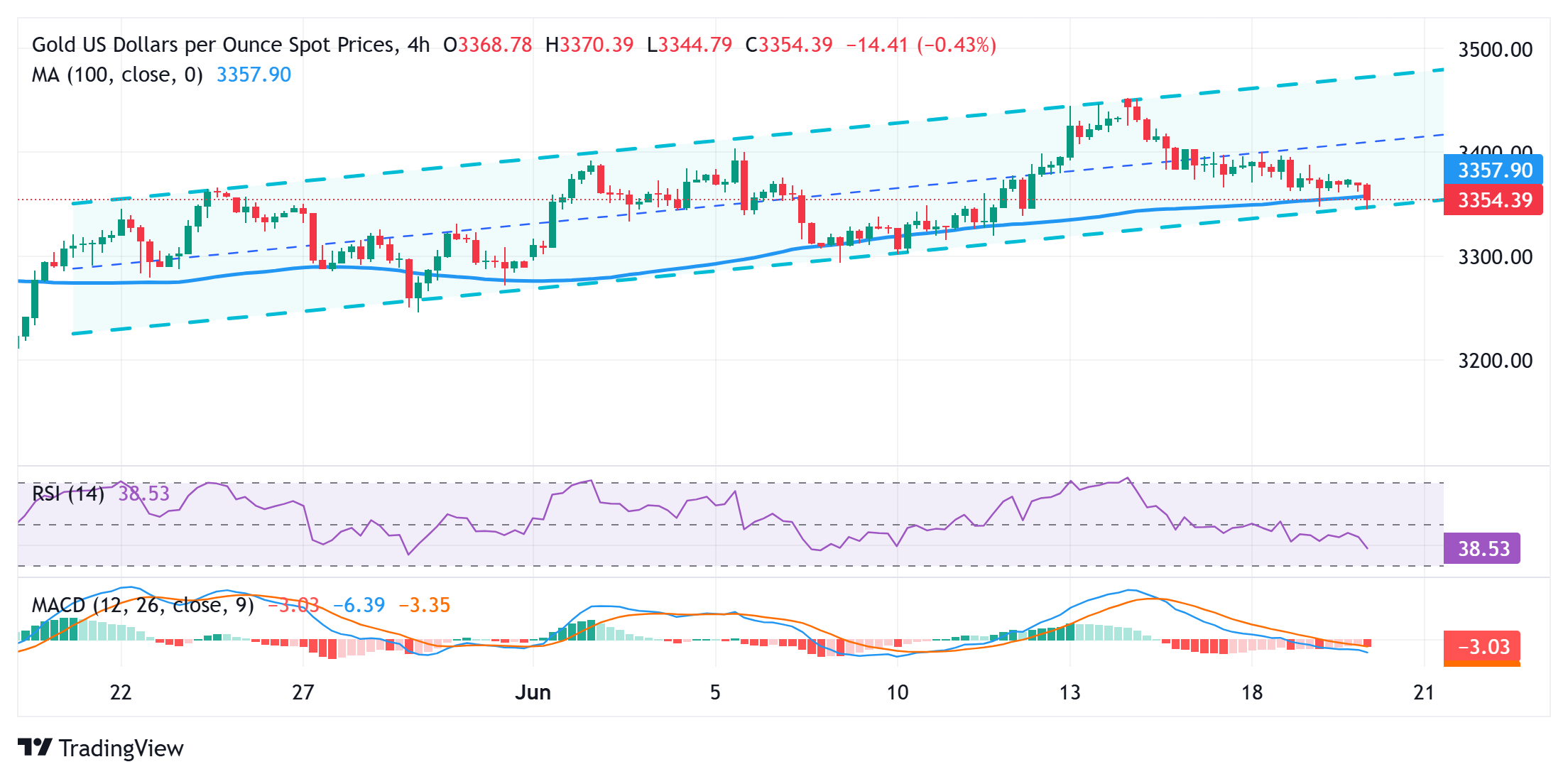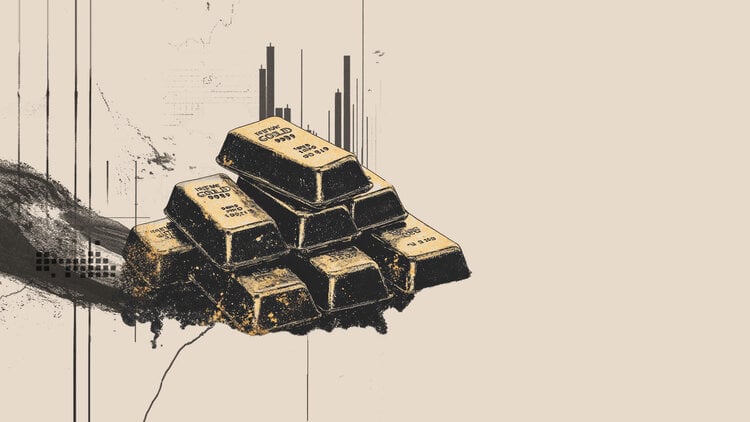- Gold price comes under renewed selling pressure despite a combination of supporting factors.
- A weaker risk tone and some follow-through USD selling do little to support the XAU/USD pair.
- The mixed fundamental backdrop warrants some caution before positioning for deeper losses.
Gold price (XAU/USD) retains its negative bias through the Asian session, although it has managed to rebound slightly from over a one-week low touched earlier this Friday. The Federal Reserve (Fed) earlier this week signaled a slower pace of interest rate cuts in the future amid still elevated inflation. This turns out to be a key factor driving flows away from the non-yielding yellow metal. The intraday downtick, however, stalls near the $3,345-3,344 area.
Despite the Fed’s hawkish stance, the US Dollar (USD) is seen moving away from the weekly top touched on Thursday and acts as a tailwind for the Gold price. Furthermore, persistent trade-related uncertainties and rising geopolitical tensions in the Middle East continue to weigh on investors’ sentiment, which contributes to limiting losses for the safe-haven bullion. This, in turn, warrants some caution before placing fresh bearish bets around the XAU/USD.
Daily Digest Market Movers: Gold price weakens as Fed’s hawkish stance offsets weaker USD and rising geopolitical tensions
- The US Federal Reserve (Fed) held interest rates steady at the end of a two-day meeting on Wednesday amid concern that US President Donald Trump’s tariffs could push up consumer prices. In the so-called dot plot, the committee projected two rate cuts by the end of 2025. However, Fed officials forecasted only one 25-basis points rate cut in each of 2026 and 2027 amid the risk that inflation could stay persistently higher.
- The global risk sentiment remains fragile on the back of persistent trade-related uncertainties and rising geopolitical tensions in the Middle East. In fact, Trump said earlier this week that tariffs on the pharma sector are coming soon. This adds a layer of uncertainty in the markets ahead of the July 9 deadline for sweeping “liberation day” tariffs and keeps investors on edge, which could benefit the safe-haven Gold price.
- On the geopolitical front, the aerial war between Iran and Israel continues for the eighth day amid speculations over a possible US involvement. According to the US Senate Intelligence Committee Chair, Trump said that he would give Iran the last chance to make a deal to end its nuclear program and delay his final decision on launching strikes for up to two weeks. This raises the risk of a broader regional war in the Middle East.
- The US Dollar is seen retreating further from over a one-week high touched on Thursday, in the aftermath of the Fed’s hawkish pause, which, in turn, could support the commodity. Moreover, the supportive fundamental backdrop suggests that the path of least resistance for the XAU/USD pair is to the upside and backs the case for the emergence of some dip-buying at lower levels heading into the weekend.
Gold price bears await break and acceptance below ascending trend-channel support before placing fresh bets

From a technical perspective, the intraday slide drags the Gold price below the 100-period Simple Moving Average (SMA), to a pivotal support marked by the lower boundary of a short-term ascending channel. Given that oscillators on the daily chart have been losing traction and gaining negative momentum on hourly charts, some follow-through selling should pave the way for an extension of this week’s retracement slide from a nearly two-month high. The XAU/USD pair might then accelerate the fall towards the $3,323-3,322 intermediate support before eventually dropping to the $3,300 round figure.
On the flip side, the $3,374-3,375 horizontal zone might now act as an immediate hurdle ahead of the $3,400 mark. A sustained move beyond the latter could lift the Gold price to the $3,434-3,435 region en route to the $3,451-3,452 area, or a nearly two-month top touched on Monday. Some follow-through buying would then allow bulls to aim towards challenging the all-time peak, around the $3,500 psychological mark, which nears the ascending channel barrier.
Risk sentiment FAQs
In the world of financial jargon the two widely used terms “risk-on” and “risk off” refer to the level of risk that investors are willing to stomach during the period referenced. In a “risk-on” market, investors are optimistic about the future and more willing to buy risky assets. In a “risk-off” market investors start to ‘play it safe’ because they are worried about the future, and therefore buy less risky assets that are more certain of bringing a return, even if it is relatively modest.
Typically, during periods of “risk-on”, stock markets will rise, most commodities – except Gold – will also gain in value, since they benefit from a positive growth outlook. The currencies of nations that are heavy commodity exporters strengthen because of increased demand, and Cryptocurrencies rise. In a “risk-off” market, Bonds go up – especially major government Bonds – Gold shines, and safe-haven currencies such as the Japanese Yen, Swiss Franc and US Dollar all benefit.
The Australian Dollar (AUD), the Canadian Dollar (CAD), the New Zealand Dollar (NZD) and minor FX like the Ruble (RUB) and the South African Rand (ZAR), all tend to rise in markets that are “risk-on”. This is because the economies of these currencies are heavily reliant on commodity exports for growth, and commodities tend to rise in price during risk-on periods. This is because investors foresee greater demand for raw materials in the future due to heightened economic activity.
The major currencies that tend to rise during periods of “risk-off” are the US Dollar (USD), the Japanese Yen (JPY) and the Swiss Franc (CHF). The US Dollar, because it is the world’s reserve currency, and because in times of crisis investors buy US government debt, which is seen as safe because the largest economy in the world is unlikely to default. The Yen, from increased demand for Japanese government bonds, because a high proportion are held by domestic investors who are unlikely to dump them – even in a crisis. The Swiss Franc, because strict Swiss banking laws offer investors enhanced capital protection.

